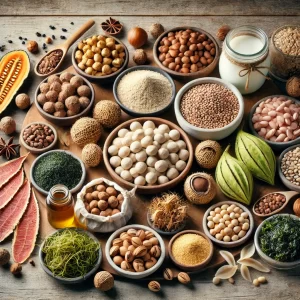
Superfoods have long fascinated health enthusiasts and wellness seekers. These nutrient-dense ingredients offer myriad benefits ranging from enhanced energy to improved immunity. However, with new superfoods constantly emerging, it can help to separate evidence-based claims from mere marketing buzz. We explored the top superfoods predicted to dominate in 2025 and give our input whether they live up to expectations. Read on!
What to Watch For
One of the most exciting superfoods gaining traction is moringa, often called the “miracle tree.” Packed with vitamins, minerals, and antioxidants, moringa is well known for its ability to support immunity and reduce inflammation and its versatility allows it to be used in powders, teas, and even snack bars, making it increasingly accessible to the health-conscious consumer.
Another rising star is tiger nuts. These are small tubers which are extremely rich in prebiotic fiber that promotes gut health. These allergen-friendly, gluten-free alternatives are being used in flour and plant-based milk, aligning with the growing demand for functional foods that cater to sensitive diets. Similarly, pili nuts, prized for their high magnesium content and buttery texture, are gaining popularity as a keto-friendly snack or ingredient in granolas and bars.
Superfoods from the sea, such as seaweed varieties like kelp, dulse, and wakame, are also in the spotlight. Seaweed is an excellent source of iodine, omega-3s, and antioxidants, offering both nutritional benefits and sustainability. You see it in innovative formats like chips, seasoning blends, and wraps, but its unique taste may not be up to everyone’s palate!
Another one to watch is the baobab fruit – known for its high vitamin C and antioxidant content – it is another nutrient powerhouse. Often used in smoothies, energy bars, and drinks, baobab supports immunity, digestion and hydration.
Ancient grains like fonio, amaranth, and millet are also being recognized not only for their nutritional value but also for their role in sustainable agriculture. These grains are adaptable to a variety of products, including crackers and porridges, making them an attractive option for eco-conscious consumers.
Lastly, fermented foods, including kefir, kimchi, and fermented grains, continue to gain popularity. With growing awareness of the gut-brain connection, these probiotic-rich options offer compelling health benefits.
The Reality Behind the Hype
While these superfoods offer undeniable nutritional benefits, they are not without their challenges. Many of them, such as pili nuts or baobab, come with a hefty price tag, limiting accessibility for some consumers. Moreover, while some claims are well-supported by science, others may be exaggerated or lack sufficient research. The taste and unfamiliarity of certain superfoods may also pose hurdles for mainstream adoption.
Finding Balance in Wellness Trends
Superfoods do play an important role in enhancing a balanced diet, but they are not magical solutions to everyone’s health problems. Their true value lies in their ability to complement a variety of other nutrient-rich foods rather than serve as standalone fixes. Consumers should prioritize superfoods that align with their dietary needs and preferences while keeping sustainability and affordability in mind.
As the wellness industry continues to innovate, 2025 promises to bring exciting opportunities to experiment with new ingredients. Let us approach these trends with an open mind and remember that even superheroes (read superfoods) need a sidekick!

Post Comments